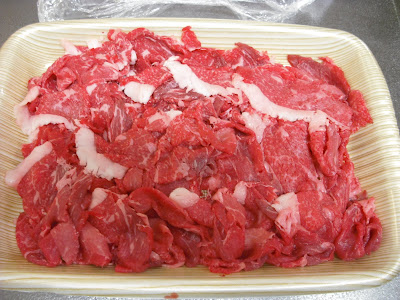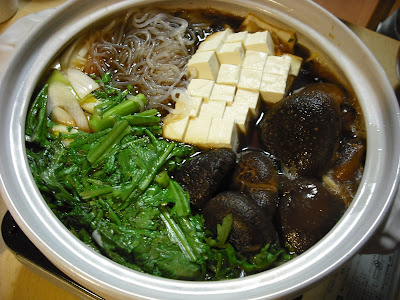新年の三日目には、新しい土鍋で作る3番目の鍋物として関東風のすき焼きを食べました。
Just take a look at the domestic (which means expensive) kuroge gyu beef.
国産の(つまり、高価な)黒毛牛を見て下さい。

This is actually kuroge gyu (black-haired cattle) shimofuri (marbled) scraps.
実際は、黒毛牛霜降りの切り落としです。
Kanto-style sukiyaki calls for warishita (a mixture of any of water, soy sauce, sake, mirin, and sugar that is prepared beforehand). I didn't want to make warishita, so I just put water, soy sauce, sake, and mirin in the donabe, and brought the mixture to a boil.
関東風すき焼きには割り下(前もって作っておく、水、しょう油、酒、みりん、砂糖の混合物)が必要です。私は割り下を作りたくなかったので、単に、土鍋に水としょう油と酒とみりんを入れ、沸騰させました。

This is the portable burner (called a casette konro in Japanese). There seem to be no such products outside of Japan.
これが携帯型バーナー(カセットコンロ)です。日本以外にはこのような製品はないようです。

This particular sukiyaki differs from the regular one in that it contains dried shiitake instead of fresh ones (because we have plenty of them as gifts) and momen dofu (< tofu) instead of yaki dofu (grilled tofu). Most importantly, we had the beef in the shabu-shabu style because we didn't want to overcook such expensive beef! I enjoyed the tender texture of the beef, but I have to say I very much prefer gyudon (beef bowl) to sukiyaki!
このすき焼きは通常のと異なり、生のシイタケの代わりに干しシイタケを使い(お土産としていっぱいもらったので)、焼き豆腐の代わりに木綿豆腐を使っています。一番重要なことは、牛肉をしゃぶしゃぶ風に食べたことです。こんな高価な牛肉を煮過ぎたくなかったので。牛肉の柔らかい食感を楽しみましたが、本当はすき焼きより牛丼のほうがずっと好きです!

11 comments:
Hello!
Wow this looks so good! So jealous!!! I agree you should never over cook high quality meat! A few years ago American Kobe Beef became popular in the US especially has hamburgers. I had eaten wagyu in Japan. American Kobe beef does not compare especially as a hamburger!
I had momiji nabe recently. Thanks for all your help ^_^
http://umailabs.com/special-venison-hot-pot-momiji-nabe-%E3%82%82%E3%81%BF%E3%81%98%E3%81%AA%E3%81%B9-%E3%82%82%E3%81%BF%E3%81%98%E9%8D%8B/
ひろゆきさんのすき焼きは美味しいそうですね。私もすき焼きとしゃぶしゃぶをよくつくります。カナダの冬はとても寒いです、だから鍋物は一番のたべものです。
じつは、中華街の店はカセットコンロがありますよ。2000-4000円ぐらいです。 このアルバータ(Alberta)の牛肉も一番人気があります。私は和牛が食べたいんですが。
新年あけましておめでとうございます。
Rose: Thanks for the URL. I visited your new blog. I must say I'm amazed! Very well done! You must have done a comprehensive research on momiji nabe! And, your momiji nabe looked so tasty!
As you pointed out in your post, momiji nabe is popular in Aichi, and another popular nabe there is kashiwa nabe. Kashiwa (= oak) means chicken in Aichi and some other parts of Japan.
Your way of removing odor from venison reminded me of how my mother used to cook whale meat. Back in 1960s, when whale meat was one of the cheapest sources of protein in Japan, my mother used to use milk to get rid of odor.
Okasan: あけましておめでとうございます。
Your sukiyaki recipe sounds good, too! I hope you post some photos of your sukiyaki when you have the time.
It's good to know that cassette konro are available in your country!
I want to have wagyu, too. As you may know, kokusan gyu 国産牛 (domestic beef) is not the same as wagyu 和牛, and what I had last night was the former!
aloha Mr.Hiroyuki,
I live in Hawaii and you can find portable gas burners such as yours at most stores here. Its commonly available at many Korean and Jpn markets.
Someone in Hawaii: Thanks for your information.
I did some googling and found that such products are avaialable in big cities in Asia, the United States, and Europe.
Made in Japan maybe?? Thanks for the correction, anyway.
Most portable burners are now made in China and Korea. With that comes the problem of quality control, with a lot of horror stories of them blowing up.
OkiHwn: Thanks for your comment. Horrible accidents occur in Japan, too, due to inappropriate uses of casette konro, such as placing two or more of them side by side and placing a long iron plate on top of them.
Check this out:
http://www.tune-in-tokyo.com/2009/04/portable-gas-cookers/
OkiHwn: That was a tragic accident. That post is not detailed enough as to how the accident happened, so I had to read all the comments!
Similar accidents, some fatal, occur in Japan, too, mostly due to improper use. In Japan, portable gas burners are required to be equipped with a safety device under the LPG Law.
Quote:
The insurance company determined that the stove was faulty – the gas canister was too close to the flame causing it to become hot and explode.
I wonder if the insurance company still believes so. Does the company imply that the stove had some design flaws??? All portable gas burners are designed in similar ways.
With that comes the problem of quality control, with a lot of horror stories of them blowing up.
Lot Adaptor
Post a Comment